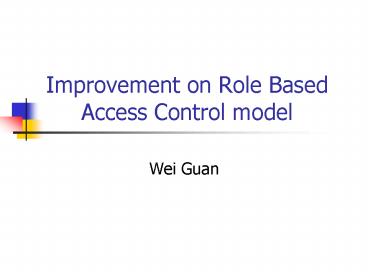Improvement on Role Based Access Control model PowerPoint PPT Presentation
1 / 12
Title: Improvement on Role Based Access Control model
1
Improvement on Role Based Access Control model
- Wei Guan
2
Introduction
- RBAC model is capable of expressing policies
especially suited for commercial applications. - It can easily mirror an organizations structure
and encourage well-structured access control
policies. - It provides a powerful mechanism for reducing the
complexity, cost and potential errors of
assigning users permissions within the
organization - It naturally supports delegation of access
permissions.
3
Definition Classification
- Sets U, R, P, and S
- PA R? P, UA U? R, user S? U, role S? 2R
- Administration cost of RBAC is reduced from a
factor of UP to a factor of UP ! - RBAC0 the basic model described above.
- RBAC1 RBAC0 with role hierarchies, including
limited inheritance achieved by introducing
private roles. - RBAC2 RBAC0 with constraints on user/role,
role/role, and/or role, permission associations. - RBAC3 consolidation model combining RBAC1 and
RBAC2, thus arising issue in applying constraints
to role hierarchy
4
Definition2
5
Specification Language RBAC96
6
RSL99 separation of duty
7
RCL2000 constraints
- Prohibition Constraints forbid the RBAC
components from doing (or being) something not
allowed based on organization policy. - Obligation Constraints force RBAC component to
do (or be) something allowed or required based on
organizational policy. - Cardinality Constraints limitation on the number
of users, roles and sessions.
8
Temporal RBAC
- Periodic events in form of (I, P, pE)
- Role triggers in form of
- E1, , En, C1, , Ck ? pE after ?t
- Requirement can be expressed as follows
- (4/19/2004, day-time, VH activate
doctor-on-daytime-duty) - TRBAC model only considers time factors from
roles perspective, so it cannot express timing
constraints in terms of protected objects, or
relationships between roles and protected sources.
9
Relationships between Entities
- Enumeration involves a manual (and often static)
specification of the subset of instances. - Object grouping involves creating groups of
instances of the same class. A role-member
acquires the associated permissions only for a
specific set of such groups. - Constraints conditions that an object must
satisfy in order to perform an operation, which
involve security-relevant parameters of the
operation, i.e. environment information, or state
contained in the target object.
10
Proposal Model
- Entity users, roles, objects (protected data,
time duration, creator, owner) or their
combinations. - Relationship such as role hierarchy, separation
of duty, and cardinality constraints, etc. - Context a collection of state information in
form of (location, time duration, relationship
between entities). - Permissions approvals to perform an operation.
- Assignment Functions AR U ? R and AP RCO ?
P. - This model can easily represent the example such
as affiliation of user, location and time,
relationship among entities in healthcare field.
11
Future work
- provide a specification language that isolate the
security concerns from other function
requirements, and allow it to be implementation
and application independent. - extend it to deal with circumstances in
healthcare domain which didnt support by current
RBACs. - modify on current definition of the model after
analysis on its administrator cost compared with
its capability - give a formal semantics for detecting
inconsistent and infeasible security policies
before deploying them.
12
Reference
- Shangping Ren. a Model and a Specification
Language for Context Dependent information Access
Control in Healthcare domain, proposal at IIT,
Mar. 2004 - R. S. Sandhu, E.J.Coyne, H.L.Feistein, and C.E.
Youman. Role Based Access Control Models. IEEE,
Feb. 1996 - Gail-Joon Ahn, Ravi Sandhu. the RSL99 Language
for Role-based Separation of Duty Constraints,
ACM, 1999 - Gail-Joon Ahn. Specification and Classification
of Role-based Authorization Policies, IEEE
international Workshops, 2003 - Bertino E., Bonatti P., Ferrari E. TRBAC A
Temporal Role-based Access Control Model. ACM,
2001 - J. Barkley, et al. Supporting Relationships in
Access Control Using Role Based Access Control,
ACM workshop, Oct. 1999 - Arun Kumar, Neeran Karnik, Girish Chafle,
Context Sensitivity in Role-based Access
Control, IBM India Research Laboratory, 2002

